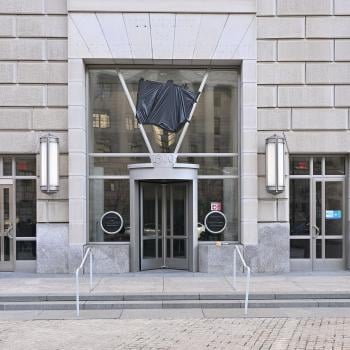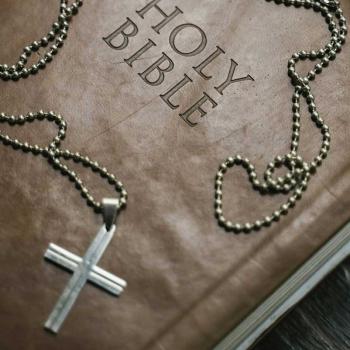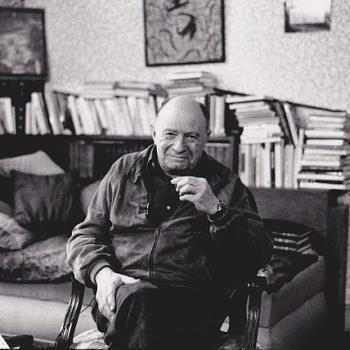What I Appreciate about Methodism
Roger E. Olson
*This is a presentation I gave to a Baptist-Methodist dialogue event held at Truett Theological Seminary of Baylor University on February 20, 2020.*

I recently endorsed a new book entitled The Spirit of Methodism by Jeffrey Barbeau. It’s one of several books with that title. Reading this book was just the most recent in a long history of my non-Methodist encounters and interactions with Methodists. But before talking about my acquaintance with Methodism, please be patient as I talk about what I mean by “Methodism.” Here, in this presentation, I am not specifically talking about the United Methodist Church but about the spirit or ethos of Methodism that stems from the ministries of John and Charles Wesley in the 18th century. That includes many churches and ministries that do not contain the word “Methodist” in their names. For example, the many so-called “Holiness churches” that arose mostly in the 19th century to renew the spirit of Methodism that they perceived as being lost in the Methodist Episcopal Church in the United States. Nazarenes, Churches of God, Wesleyans, even the Salvation Army—all are part of the spirit of Methodism. Then there are those “other Methodists” such as the Free Methodist Church and the Evangelical Methodist Church—small Methodist denominations not part of the United Methodist Church. These I also consider when I think and talk about the spirit of Methodism. So, to me, “Methodism” is trans-denominational.
Now, a little bit about my own personal encounters and interactions with Methodism. My stepmother and her many siblings, my aunts and uncles, were raised in the Methodist Episcopal church in Iowa. Some of them, including my stepmother, became Pentecostals through the ministry of evangelist Aimee Semple McPherson who belonged to the Salvation Army before founding her own quasi-Methodist Pentecostal International Church of the Foursquare Gospel. My grandparents on my father’s side were member of the Church of God (Anderson, Indiana) whose founder Daniel Warner was a Methodist (among other things). When I was a child and youth my parents took me every summer to the Nazarene camp meeting in West Des Moines and I knew many Nazarenes when I was growing up. During my doctoral studies at Rice University my mentor was Methodist theologian Niels C. Nielsen. Another professor was Methodist James Sellers. I taught a series on Wednesday evenings at Memorial Drive Methodist Church in Houston. In 2003 I was invited to give a plenary address about Wesley’s Arminian theology at Asbury Theological Seminary’s celebration of Wesley’s 300th birthday. I have spoken at Methodist churches including First United Methodist of The Woodlands. I have two books published by the United Methodist Publishing House/Abingdon Press and perhaps my greatest claim to Methodism is Adam Hamilton, pastor of the United Methodist Church of the Resurrection, a mega-church in Kansas City, Kansas. Adam was in the very first theology class I taught at Oral Roberts University. When I taught at ORU it was trying to become a Methodist-related university and seminary. Many of the professors in the Graduate School of Theology were UMC ministers and one, I recall, was a retired UMC bishop. I had lively interactions with them. Over the years I have formed relationships with UMC theologians such as Billy Abraham, Don Thorsen, and Kenneth Collins.
Now to what I appreciate about the Methodist tradition. Again, I want to say that my focus will be on the spirit of Methodism, not any particular Methodist denomination or church.
The Methodist spirit is experiential.
The Methodist spirit is Arminian.
The Methodist spirit is activist.
The Methodist spirit is transformational.
The Methodist spirit is ecumenical.
The Methodist spirit is quadrilateral.
The Methodist spirit is intellectual.
First, then, the Methodist spirit is experiential. This goes back to John Wesley’s famous “warmed heart” experience at a Moravian gathering on Aldersgate Street in London on May 24, 1738. To this day many Methodists celebrate May 24 or the Sunday closest to it as “Aldersgate Day.” Debate continues among Methodists over whether this experience was Wesley’s “conversion” or simply a kind of epiphany. I personally know two influential Methodist scholars who disagree about that I’ve heard them debate it publicly. I respect them both and don’t take a side. However, clearly, it was an emotional experience for Wesley, an experience of immediacy of God to his soul, his heart. At their best Methodists have always emphasized the importance of having what I will call “epiphanies” of God the Holy Spirit in the heart. And in the Methodist spirit these are not just new insights of the mind; they are “inner man” experiences as the Pietists called them. Methodism was strongly influenced by European Pietism but took it to a new level while at the same time avoiding some of its excesses.
What I am talking about here is best illustrated by pointing to alternative views of Christian experience and spirituality. Many Christians in Wesley’s time viewed becoming Christian and remaining Christian as primarily a matter of learning doctrines and giving mental assent to them. Many others emphasized Christian initiation and existence as primarily a matter of worshiping in the right way—according to a defined liturgy—and participating in the sacraments. Finally, many other Christians have regarded Christian initiation and existence as primarily about using the will to turn over a new leaf and do the will of God as a matter of duty.
Wesley and the spirit of Methodism do not discard these as invaluable, but they view them as insufficient for holistic, robust Christian existence. Experiencing God in the “inner man” such that one’s “heart” feels “strangely warmed” lies at the center of the spirit of Methodism. And as a post-Pentecostal Pietist Baptist I love that about the spirit of Methodism.
Second, the Methodist spirit is Arminian. People who know me well will not be surprised that I bring that up here. The first Baptists were also Arminians—whether they used that label or not. They probably did not. However, John Wesley knew he was Arminian; he named his magazine The Arminian. But he was what theologian Alan P. F. Sell called an “Arminian of the heart” and not an “Arminian of the head.” During Wesley’s life many Arminians had become theologically liberal; Wesley did more than anyone else to reclaim true, historical Arminianism—as it was intended by Jacob Arminius himself and his immediate followers the early Remonstrants. So what does this mean? I have written a whole book about it and I will be shameless here and mention that: Arminian Theology: Myths and Realities published by InterVarsity Press. In it I quote Wesley extensively—together with later Methodists such as Philip Watson and John Miley. In a nutshell “Arminianism” simply means belief that sinners are given the free will by God to repent and believe in Jesus Christ and that whether they do so or not is not determined by God alone. The sinner who repents and believes unto conversion is not earning or meriting any part of his or her salvation but is freely choosing, enabled by prevenient grace, to cooperate with God’s saving grace. Grace alone is the efficient cause of salvation, but human repentance and faith are the instrumental causes of salvation. In other words, Arminians are Christians who reject unconditional election, limited atonement, and irresistible grace—hallmarks of the Calvinist system of belief.
Third, the Methodist spirit is activist. Wesley was renowned as a revivalist and there have been many Methodist revivalists. The revivalist spirit may have been born with Wesley and his colleague George Whitefield—also a Methodist (even if a Calvinist one). But evangelism was not the only activity dear to their hearts or to Methodism since its beginning in the revival fires of the Evangelical Awakening. Methodists were in the forefronts of social change from the beginning. Wesley strongly opposed slavery as did many Methodist in the nineteenth century. The first Christian denomination to ordain women was the Free Methodist Church—on offshoot of the Methodist Episcopal Church around 1860. Deliverance from oppression has long been at the heart of Methodist activism. One of the only Protestant Latin American liberation theologians, Jose Miguez Bonino, was an Argentinian Methodist. All around the world Methodism has been a light of liberation from all that dehumanizes people—from sin to sexism to racism to poverty.
Fourth, the Methodist spirit is transformational. Wesley was not satisfied for himself or his followers merely to be forgiven and reconciled to God; he wanted himself and his followers to be transformed inwardly—even promoting the possibility of “entire sanctification” if not sinless perfection. His heart was not only warm; it was filled with love. Wesley himself never claimed to be entirely sanctified, perfected in love, but he preached that possibility—even before the resurrection. Something that is not well known about Wesley, even among Methodists, is that he was strongly attracted to the Eastern Orthodox concept of deification (“theosis”)—becoming partial partakers of the divine nature-through faith. Ever since Wesley, Methodists have rejected the typical Lutheran idea of simul justus et peccator—“always righteous and a sinner at the same time.” They have preached and taught that the Holy Spirit can so invade and take over a person’s heart and mind that he or she rises above the constant struggle with sin.
Fifth, the Methodist spirit is ecumenical. Wesley’s motto toward non-Methodist Christians was “If your heart is as mine, give me your hand.” In other words, even if we disagree about some doctrines and about the sacraments and about church government, if your heart has been truly warmed by the Holy Spirit and is warm toward God and the things of God, we can cooperate. So far as I know Methodists have always had open communion. They have been in the forefront of ecumenical dialogue and cooperation between Christian denominations and communities. Wesley did not intend to found a separate denomination; that happened as a result of his appointing bishops to lead the Methodist churches in America when they could not function under the authority of the Church of England because of the War of Independence. It was the Church of England that broke off fellowship and created a schism with Methodism. Wesley always only intended Methodism to be a renewal movement within the Church of England. Ever since then Methodist denominations have been reluctant sectarians, always seeking out other warm-hearted and activist Christians for cooperation and fellowship.
Sixth, the Methodist spirit is quadrilateral. Methodist scholar Albert Outler created this term to describe John Wesley’s approach to doctrine and theology. Scripture, tradition, reason, and experience are the four sources and norms of Methodist theology and doctrine. I personally think that this approach existed before Wesley. In fact, he borrowed it partly from Church of England theologian Richard Hooker but added “experience” to Hooker’s “three legged stool” of Christian authority which omitted it. I think Christians have always taken experience into account in developing doctrine and theology and church practice—whether they call it a “quadrilateral” or not. But Methodists have especially elevated and promoted the so-called “Wesleyan Quadrilateral” as the proper method for carrying out the critical and constructive tasks of theology. I agree with them, but I am confident that, contrary to some modern Methodist theologians, Wesley would have insisted that the quadrilateral is not an equilateral; Scripture trumps tradition, reason and experience if there’s any conflict between them. The Methodist spirit, at its best, has always focused on the Bible as the supreme source and norm for Christian belief and practice but without neglecting other sources such as tradition. Wesley himself was steeped in the church fathers, for example, and held firmly to the Nicene Creed. But when the Bible was not as clear about a subject as he wished it would be, Wesley turned to tradition, reason and experience as tools for understanding the Bible and supplementing it.
Seventh, and finally, the Methodist spirit is intellectual. Revivalism and intellectualism are often considered alternatives, competitors, incompatible with each other. The Methodist spirit, however, has always, at its best, combined them. My favorite biography of John Wesley is Reasonable Enthusiast by Henry D. Rack (Abingdon Press). The “hook” of the title is that it seems to signal an oxymoron. “Enthusiast” was a bad word in England in Wesley’s time; it was the equivalent of today’s “fanatic.” “Reasonable” speaks for itself. But being reasonable is not what many people think of when they hear John Wesley’s name mentioned. Nevertheless, like his American revivalist counterpart Jonathan Edwards, Wesley was a highly educated scholar, a modern man in many ways. His critics, such as Bishop Joseph Butler, did not see Wesley as reasonable, but that says more about Butler than about Wesley.
I won’t go more deeply into the reasons for Rack’s title; I will only strongly suggest that you read the book if you are interested in Wesley’s life, character, career—and the Methodist spirit he created.
At its best, throughout three centuries plus, the Methodist spirit has encouraged education, biblical and theological scholarship. Methodists have founded many universities and seminaries around the world. Westminster College, Oxford University, was founded by Methodists. In the United States one can mention Boston University, Duke University, Northwestern University and many others—as examples of Methodist intellectualism. For those of us devoted to the evangelical spiritual ethos mention must be made of Asbury College and Seminary, Seattle Pacific University, and the numerous Free Methodist schools such as Roberts Wesleyan University.
Methodism has put its indelible stamp on American culture. One scholar of American religious history, I don’t remember who at the moment so I’ll just say it was Martin Marty, called the nineteenth century in America “the Methodist century.” During that century Methodism grew from a tiny sect still somewhat attached to the Church of England to a robust and independent truly American denomination that had more members than any other American religious group. At its height the Methodist Episcopal Church, now known as the United Methodist Church, had almost fifteen million members in the U.S. and many, many more around the world. Membership in the UMC has declined in the U.S. but the Methodist spirit lives on in numerous churches and institutions even outside the UMC’s own boundaries.
As editor of the 14th edition of the Handbook of Denominations in the United States (published by Abingdon Press) I found nineteen distinct denominations that I would say embody the Methodist spirit each in its own way. Each one looks back to the ministry of John Wesley as the founder of its distinctive Christian ethos with strong emphasis on sanctification. Many Pentecostal denominations are not included among those nineteen but were founded by people imbued with the Methodist spirit.
Especially in the South, Methodists and Baptists have often been regarded as competitors, but those days are fading away. Today Methodists and Baptists find much common ground. Speaking only for myself, I would say that Baptist could learn something about church connexionalism from Methodists even as we maintain the formal autonomy of the local congregation. I believe we also can learn from Methodists much about the Holy Spirit’s power to sanctify people toward, if not into, true holiness of mind and heart. And I believe we can also learn much from Methodists about how mind and heart can work together, how we can be “reasonable enthusiasts.”
*As always, here, on this blog, I speak for no one but myself. If you choose to post a response, please make sure it is civil, kind, and respectful. Please keep your response brief and do not include a photo, image or internet link in it.*












